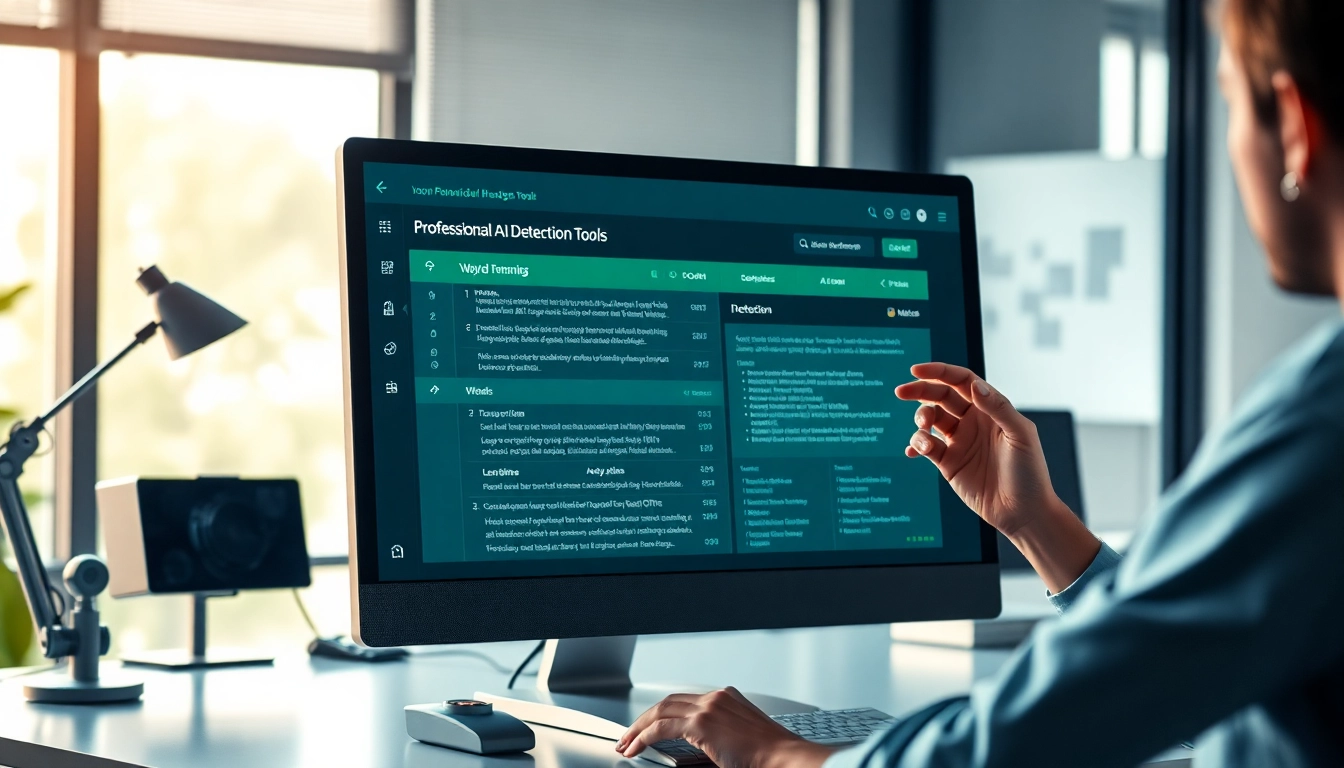Understanding crushai: An Introduction to AI-Driven Data Analytics
In the dynamic landscape of business, data has emerged as a cornerstone for decision-making. The rise of artificial intelligence has transformed how data is analyzed and leveraged. One of the most significant advancements in this area is crushai, an AI-driven analytics tool designed to empower businesses by providing insightful data analysis. This article explores the fundamentals of crushai, its implementation, competitive advantages, and the promising future it holds for data analytics.
What is crushai and how does it work?
At its core, crushai is an advanced analytics platform that employs artificial intelligence and machine learning algorithms to derive actionable insights from vast datasets. By automating data collection and analysis, crushai reduces the time and effort traditionally required for data interpretation. It offers features such as natural language processing, data visualization, and predictive analytics, making it easier for users to understand complex data patterns.
Crushai’s operation hinges on several key components:
- Data Integration: Crushai can connect with multiple data sources, including databases, CRM systems, and even social media platforms, allowing businesses to consolidate their data into one comprehensive dashboard.
- Automated Analysis: Utilizing AI algorithms, crushai analyzes data to identify trends, anomalies, and correlations without the need for manual intervention.
- Predictive Analytics: By leveraging historical data, crushai forecasts future trends, helping businesses make informed strategic decisions.
- Visual Reporting: The platform offers intuitive visualizations and customizable reports, enabling users to present data in a clear and actionable format.
Key features of crushai analytics tools
The effectiveness of crushai lies in its multi-faceted features that cater to diverse analytical needs. Some of the standout features include:
- Machine Learning Capabilities: Crushai can adapt its algorithms based on new data, improving accuracy over time.
- Real-Time Data Processing: Access to live data allows businesses to make decisions based on the most current information available.
- Customizable Dashboards: Users can tailor their dashboards to focus on specific metrics pertinent to their business objectives.
- Collaboration Tools: Built-in features facilitate teamwork, allowing users to share insights and findings seamlessly.
- Natural Language Queries: Users without a technical background can interact with the data through simple questions, making analytics accessible to all employees.
Common misconceptions about AI data analysis
Despite the proliferation of AI in data analysis, several misconceptions persist that can hinder its adoption. Understanding these misconceptions is crucial for effective implementation:
- AI Replaces Human Analysts: One prevalent myth is that AI will completely replace human analysts. While crushai automates many tasks, human insight and context are irreplaceable for nuanced decision-making.
- AI is Only for Large Companies: Many believe that AI tools are resource-heavy and suitable only for large enterprises. In reality, crushai is scalable and beneficial for businesses of all sizes.
- Data Privacy Concerns: Some organizations fear that using AI in analytics compromises data privacy. However, crushai implements robust protocols to protect sensitive information while optimizing its use.
Implementing crushai for Your Business: Step-by-Step Guide
The implementation of a new analytics tool like crushai involves careful planning and execution to ensure its success. This comprehensive guide walks you through the essential steps of integrating crushai into your business processes.
Essential preparations before using crushai
Before diving into crushai, organizations need to lay the groundwork for successful implementation:
- Define Objectives: Clearly outline what you aim to achieve with crushai. Whether it is improving business forecasting, enhancing customer understanding, or optimizing internal processes, having defined goals will guide your usage.
- Data Quality Assessment: Evaluate your existing data’s quality and completeness. Poor data quality can severely affect an AI system’s effectiveness.
- Stakeholder Buy-In: Engage with key stakeholders across departments to ensure support and help facilitate a smoother transition to crushai.
Integrating crushai with existing systems
The effectiveness of crushai is often tied to how well it integrates with existing systems. Here are some strategies for successful integration:
- API Connections: Leverage application programming interfaces (APIs) provided by crushai to connect it with current systems such as ERP, CRM, or existing BI tools.
- Data Migration: Safeguard your data by ensuring a smooth migration process to crushai. This may involve transforming data formats or cleansing corrupt data.
- Training Sessions: Schedule training for team members on how to optimize the use of crushai for their specific roles.
Common challenges in implementation and their solutions
Implementing a new analytics solution can introduce several challenges. Some common issues, along with their solutions, include:
- Resistance to Change: Employees may resist new systems. Solution: Engage in continual dialogue about the benefits of crushai and involve employees in the implementation process.
- Technical Issues: Technical problems may arise during integration. Solution: Collaborate with crushai’s technical support for assistance and consider having internal IT staff available for faster resolutions.
- Budget Constraints: The costs associated with adopting new technology may be a concern. Solution: Calculate the expected ROI from using crushai to secure management buy-in on budget allocation.
Leveraging crushai for Competitive Advantage
Once implemented, crushai can provide significant competitive advantages for organizations using it effectively. Here are methods to leverage its capabilities.
Identifying key metrics that matter for your business
Understanding the metrics that are critical to your business’s success is paramount. Start by considering the following factors:
- Business Objectives: Align metrics with strategic objectives for better relevance. For instance, if customer retention is a goal, analyze churn rates.
- Industry Standards: Review common metrics in your industry to measure against competitors effectively.
- Customer Insights: Focus on metrics that provide insight into customer behaviour, preferences, and satisfaction.
How to utilize crushai for predictive analytics
Predictive analytics is one of the most powerful applications of crushai. Users can apply the following techniques to benefit from predictive features:
- Data Segmentation: Group data based on selected attributes to refine predictions. This segmentation enables tailored analytics for specific demographics.
- Scenario Analysis: Use crushai to conduct “what-if” analyses that help visualize how different changes would impact outcomes.
- Continuous Learning: Allow crushai to learn from new data to refine predictions automatically, thereby enhancing accuracy over time.
Case studies of successful crushai utilization
Real-life examples provide concrete evidence on the effectiveness of crushai. Consider these successful case studies:
- Retail Company Transformation: A major retail chain implemented crushai to analyze customer purchasing behavior. By harnessing its predictive capabilities, they improved their inventory management, reducing excess stock by 30% while increasing sales by 15% in just one year.
- Healthcare Analytics: A healthcare provider utilized crushai to analyze patient data, leading to a 20% reduction in hospital readmissions through targeted follow-ups. The insights gained paved the way for enhanced patient therapies.
Measuring Success with crushai: KPIs and Performance Metrics
To ensure that crushai delivers on its promised value, organizations must implement tangible performance metrics and KPIs. This section discusses effective measurement strategies.
Defining meaningful KPIs for data analytics
A critical aspect of data analysis is establishing KPIs that truly reflect business performance:
- Alignment with Goals: Focus on KPIs that directly link to your company’s strategic objectives for clear accountability.
- Actionability: Choose KPIs that result in actionable insights rather than just reporting metrics alone.
- Periodical Review: Regularly re-evaluate the relevance of selected KPIs as business priorities and market conditions evolve.
Tools to track performance and insights
Various tools work in tandem with crushai for tracking and analyzing performance:
- Dashboards: Utilize crushai’s built-in dashboard tools to visualize performance in real-time, allowing for instant decision-making.
- BI Tools: Integrate business intelligence tools for deeper analytics, allowing for more sophisticated data manipulation.
- Reporting Features: Take advantage of customizable reporting tools to present data insights to stakeholders effectively.
Iterating and refining analytics strategies
Analytics is not a one-time task but an ongoing process. Here are ways to refine your approach:
- A/B Testing: Conduct experiments to assess the impact of different strategies, allowing for an iterative approach to optimization.
- Feedback Loops: Establish a system for collecting feedback from analytics users and stakeholders to identify potential improvements.
- Continuous Learning: Stay updated with the latest trends and features in crushai to leverage advancements in your strategy.
The Future of Data Analytics with crushai: Trends and Innovations
The rapid evolution of technology continuously reshapes the landscape of data analytics. As we look towards the future, here are emerging trends that will shape the way organizations utilize crushai and similar platforms.
Emerging technologies in AI data analytics
Several technological advancements are poised to enhance AI-driven data analytics:
- Artificial General Intelligence (AGI): The next phase in AI evolution could lead to more holistic and independent data analytics capabilities.
- Augmented Analytics: This combines AI with human judgment, providing enhanced insights through more intuitive user interactions with data.
- Edge Analytics: With the rise of IoT, analytics performed on devices at the location of data generation will offer real-time insights for immediate action.
Preparing for advancements in crushai capabilities
Organizations must anticipate and prepare for the upgrades that will come with crushai developments:
- Continued Training: Invest in ongoing education for employees to keep pace with crushai’s evolving capabilities and features.
- Scalability Planning: Develop plans that account for increased data volumes and complexity as business needs grow.
- Integration Flexibility: Ensure that your systems are adaptable to seamlessly integrate with future enhancements and third-party technologies.
How to stay ahead in a fast-evolving landscape
To maintain a competitive edge in the face of rapidly changing technology, businesses should consider the following strategies:
- Networking and Collaboration: Engage with industry leaders through forums and conferences to share insights and stay informed about best practices.
- Investing in Innovative Solutions: Don’t hesitate to explore and invest in emerging technologies and solutions that can complement crushai.
- Fostering a Data-Driven Culture: Create an organizational culture that values data-driven decision-making across all levels to maximize the use of analytics for strategic growth.




